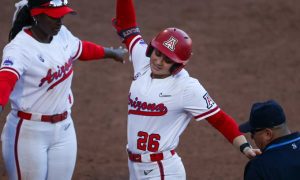FOLLOW @JAVIERJMORALES ON TWITTER!
[rps-paypal]
[ezcol_1half id=”” class=”” style=””]

|
TABLE OF CONTENTS: — General history — J.F. “Pop” McKale — The games — Comparisons then and now — Wildcats nickname — Military service — Rankings |
LAST WEEK: — No. 64: 1964 homecoming celebration — No. 65: Color barrier broken in 1949 — No. 66: Three members of team also part of band — No. 67: Majority of team came from other parts of country — No. 68: Top 10 Arizona moral victories — No. 69: Much gained after ultimate moral victory — No. 70: Team traveled by Southern Pacific |
[/ezcol_1half]
[ezcol_1half_end id=”” class=”” style=””]
Clipping of actual L.A. Times article published Nov. 8, 1914
Excerpt from L.A. Times, Nov. 8, 1914, authored by Bill Henry:
“Arizona’s cactus-fed athletes, despite heroic efforts on the part of their two halfbacks, (Asa) Porter and (Franklin) Luis, went down to defeat before the Occidental Tigers yesterday afternoon, the tally with all precincts heard from being 14 to 0 in favor of the Tigers.
Confident of rolling up a big score, the Tigers took the field with grins on their faces, but before the game was 10 seconds old they knew they had a battle on their hands.
The Arizona men showed the fight of wild cats and displayed before the public gaze a couple of little shrimps in the backfield who defied all attempts of the Tigers to stop them.”This site will conduct a countdown in a 100-day period, leading up to Arizona’s 2014 football season-opener with UNLV on Aug. 29 at Arizona Stadium. The 100 Days ‘Til Kickoff countdown will include information daily about the historic 1914 Arizona team that helped create the school’s nickname of “Wildcats” because of how they played that fateful day against Occidental.
[/ezcol_1half_end]
[ezcol_1half id=”” class=”” style=””]
Long before Woody Hayes implemented his “three yards and a cloud of dust” offense at Ohio State, the Arizona “Varsity” and college football as a whole, literally turned up dust by running out of a loaded backfield. Arizona played on a dirt field in 1914 adjacent to Old Main.
The quarterback had three players behind him — two halfbacks and a fullback — on nearly every play similar to a “T” formation. The quarterback often was used as a blocking back for one of the three runners behind him.
Because of rugby’s influence on the game at that time, many plays looked like a scrum with a bulk of players piled at the line of scrimmage. J.F. “Pop” McKale, who brought the T-Formation with him from Tucson High School, relied on three of his fastest athletes in the backfield (Franklin Luis, Asa Porter and Orville “Speedy” McPherson) to make plays out of the backfield via the run or the pass.
[/ezcol_1half]
[ezcol_1half_end id=”” class=”” style=””]
[/ezcol_1half_end]
The rounded football used in that era was not conducive for downfield passing. Arizona “Varsity” quarterback Albert “Bumps” Crawford either handed the ball off to his fleet-footed backs or on many occasions executed a forward lateral pass.
The underhanded forward lateral pass was the common pass of that era. Furthermore, the rules at that time dictated that the passer needed to execute the pass within a five-yard area on either side of the center who snapped the ball. A pass was declared illegal if it went more than 20 yards in the
air.
To help the referees some fields had five yard grips painted on the field, hence the name “gridiron” for football. Moreover, if a pass was touched and then dropped by a potential receiver, a free ball much like a fumble resulted.

The 1914 Arizona football team that earned the honor of being named the first “Wildcats” was composed of (front row, left to right): Verne La Tourette, George Seeley, Leo Cloud, Richard Meyer, Asa Porter. Second row: Franklin Luis, Lawrence Jackson, Ray Miller, J.F. “Pop” McKale (coach), Turner Smith, Harry Hobson (manager), Orville McPherson, Albert Crawford, Ernest Renaud. Back row: Albert Condron, Emzy Lynch, Charley Beach, Vinton Hammels, Bill Hendry, George Clawson, Harry Turvey.
(AllSportsTucson.com graphic/Photo from University of Arizona Library Special Collections)
[ezcol_1half id=”” class=”” style=””]
What they were talking about on this day in 1914
Saturday, June 27, 1914
Jack Johnson, the first African-American heavyweight champ, retained his title with a 20-round decision over Frank Moran in Paris, France. The Associated Press story made it a point to write about Johnson’s Anglo wife cheering him on near the top of its story. “Johnson’s white wife occupied a prominent position near ringside,” the story reads. “She was wearing as many diamonds as did most of the great society women present. She cried out shrilly from time to time: “Hit him, Daddy!”, “Come along, Pop!”, and “Now, then, Jack, let him have another!”
[/ezcol_1half]
[ezcol_1half_end id=”” class=”” style=””]
[/ezcol_1half_end]
Football coaches did not warm up to the idea of the forward pass because of these rules. The pass was not instituted into football until 1906, when President Theodore Roosevelt summoned a blue-ribbon committee of university administrators to reduce the brutality of the sport.

The single-wing melon-shaped ball measures from 28 to 22 inches in circumference, while the modern ball measures approximately 21 inches.
The pass at that time was viewed as a way to eliminate violent situations in pileups at the line of scrimmage.
Bill Henry’s account of the 1914 game between Arizona and Occidental makes it clear that both teams predominantly ran the ball. He writes of Arizona’s “little shrimps” (Porter and Luis) out of the backfield “who defied all attempts of the Tigers to stop them”.
McKale was not a fan of the forward pass extending into his later years as Arizona’s coach. In the book They Fought Like Wildcats by Abe Chanin in 1979, McKale jokes with one of his quarterbacks Jake Meyer after a loss to Rice in 1916.
“McKale called me Rice’s best passer,” Meyer told Chanin. “Guess they picked off quite a few of my passes that day.”
As for the play calling itself, McKale did something to the extreme, kind of like Oregon does today with those huge flash cards that have celebrity faces signaling different plays.
He joked with Chanin about his 1919 team: “Most of (his players) can talk Mexican as well as English and when we get away from home they use Mexican rather than English to call their play signals. And you can imagine how that can confuse their opponents.”
ALLSPORTSTUCSON.com publisher, writer and editor Javier Morales is a former Arizona Press Club award winner. He also writes articles for Bleacher Report and Lindy’s College Sports.




























